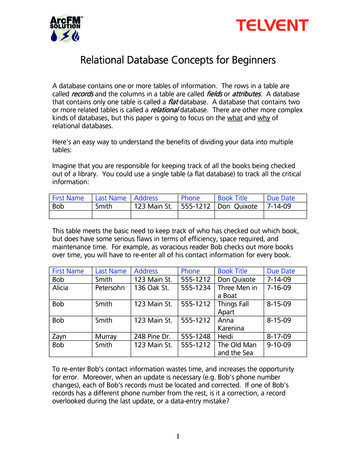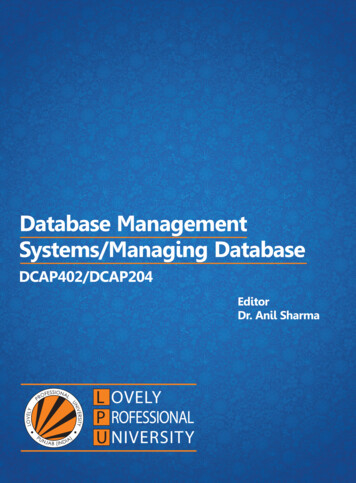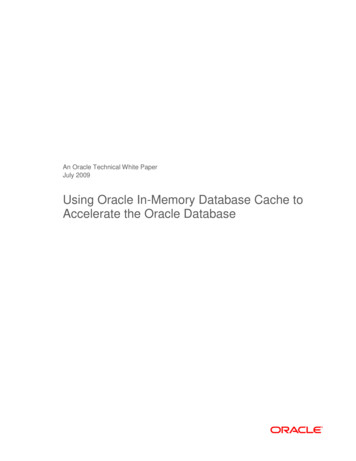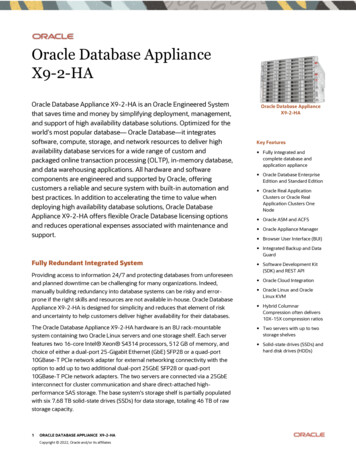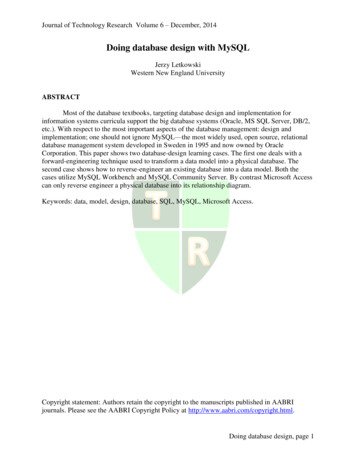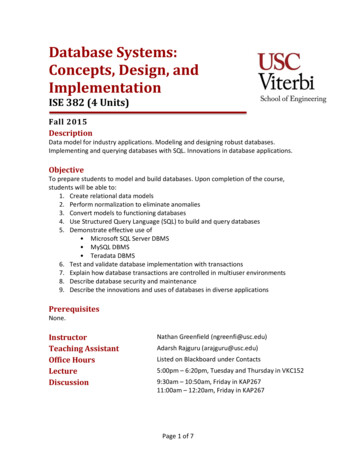
Transcription
Database Systems:Concepts, Design, andImplementationISE 382 (4 Units)Fall 2015DescriptionData model for industry applications. Modeling and designing robust databases.Implementing and querying databases with SQL. Innovations in database applications.ObjectiveTo prepare students to model and build databases. Upon completion of the course,students will be able to:1. Create relational data models2. Perform normalization to eliminate anomalies3. Convert models to functioning databases4. Use Structured Query Language (SQL) to build and query databases5. Demonstrate effective use of Microsoft SQL Server DBMS MySQL DBMS Teradata DBMS6. Test and validate database implementation with transactions7. Explain how database transactions are controlled in multiuser environments8. Describe database security and maintenance9. Describe the innovations and uses of databases in diverse applicationsPrerequisitesNone.InstructorTeaching AssistantOffice HoursLectureDiscussionNathan Greenfield (ngreenfi@usc.edu)Adarsh Rajguru (arajguru@usc.edu)Listed on Blackboard under Contacts5:00pm – 6:20pm, Tuesday and Thursday in VKC1529:30am – 10:50am, Friday in KAP26711:00am – 12:20am, Friday in KAP267Page 1 of 7
TextbookDatabase Systems, 11th Edition. Coronel and Morris. Cengage Learning,ISBN 978-1-285-19614-5.Additional material can be found at Safari Books rds/database.php?db AK3WebsiteAll course material will be posted on Blackboard (http://blackboard.usc.edu).We will use Piazza for discussions/questions outside of class.GradingThe following percentage breakdown will be used in determining the grade for the course.Labs (percentages vary)5%Homework (percentages vary)15%Exam 115%Exam 215%Project 110%Project 215%Final Project25%Total100%Grading ScaleThe following shows the grading scale to be used to determine the letter grade.93% and aboveA90% - 92%A87% - 89%B 83% - 86%B80% - 82%B77% - 79%C 73% - 76%C70% - 72%C69%D 67% - 68%D66%D65% and belowFPage 2 of 7
PoliciesAssignmentsEach assignment must be completely individually. There are no group projects in this class.The assignments will be posted on Blackboard in the “Assignments” section. Eachassignment will include instructions, a due date, and a link for electronic submission.Assignments must be submitted using this link.It is your responsibility to submit your assignments on or before the due date. Assignmentsturned in one day late will have 20% of the total points deducted from the graded score.Assignments turned in two days late will have 50% of the total points deducted from thegraded score. After two days, submissions will not be accepted and you will receive a 0.All assignments must be digitally submitted through Blackboard except when otherwisespecified by the course staff. Do not email assignments to the instructor or lab assistant.Assignment questions should be posted to the online question forum. Do not send anyemail to the instructor regarding assignments or ask specific assignment questions duringthe lecture sessions. You are encouraged to attend the instructor’s office hours forassignment related questions.Lab practicalsThere will be lab practicals during most discussion sessions. These practicals will beimmediate application of the material presented in lecture. These practicals will be graded aspass/fail. For credit on each practical you must complete the practical before discussion timehas ended. Each practical will contribute to your overall grade. There is no way to make up amissed practical, however a practical grade can be dropped provided either prior instructorapproval or a documented emergency.ProjectsThere are three projects in all. All projects are group projects. Teams of 2 students each willbe formed after the 1st exam. The three projects are separate projects although they usesimilar skills. The project scenarios are different. The projects are not demonstrated to theclass, rather the instructor/TA will evaluate the working databases on the Viterbi ITprovisioned servers. So the demo is a virtual one. Each project will have its own grading rubric.Page 3 of 7
Policies (continued)ExamsMake-ups are only allowed under extraordinary circumstances. Students must provide asatisfactory reason (as determined by the instructor) along with proper documentation.There are two exams. These exams are comprehensive of all topics covered.Lab facilitiesYou are encouraged to save your work using a USB flash drive or a website such as Dropbox.You must keep a copy of all coursework. You will not be able to save your work on the ITPlab computers. Any work saved to the computer will be erased after restarting thecomputer.The class staff is not responsible for any work lost.Furthermore, students will be able to install all of the necessary software on their owncomputers in order to be able to work on the homework at any time. Both Mac and PC aresupported. Students without their own personal computers are able to utilize the 24-hourUSC computing centers.Incomplete and Missing GradesExcerpts for this section have been taken from the University Grading Handbook, located ok/index.html. Please see the linkfor more details on this and any other grading concerns.A grade of Missing Grade (MG) “should only be assigned in unique or unusual situations for those cases in which a student does not complete work for the course before thesemester ends. All missing grades must be resolved by the instructor through the Correctionof Grade Process. One calendar year is allowed to resolve a MG. If an MG is not resolved[within] one year the grade is changed to [Unofficial Withdrawal] UW and will be calculatedinto the grade point average a zero grade points.”A grade of Incomplete (IN) “is assigned when work is no completed because of documentedillness or other ‘emergency’ occurring after the twelfth week of the semester (or 12th weekequivalency for any course scheduled for less than 15 weeks).”Page 4 of 7
Statement on Academic Conduct and Support SystemsAcademic ConductPlagiarism – presenting someone else’s ideas as your own, either verbatim or recast in yourown words – is a serious academic offense with serious consequences. Please familiarizeyourself with the discussion of plagiarism in SCampus in Section 11, Behavior ViolatingUniversity Standards iversitystandards-and-appropriate-sanctions/. Other forms of academic dishonesty are equallyunacceptable. See additional information in SCampus and university policies on scientificmisconduct, imination, sexual assault, and harassment are not tolerated by the university. You areencouraged to report any incidents to the Office of Equity and Diversityhttp://equity.usc.edu/ or to the Department of Public -public-safety/online-forms/contact-us.This is important for the safety whole USC community. Another member of the universitycommunity – such as a friend, classmate, advisor, or faculty member – can help initiate thereport, or can initiate the report on behalf of another person. The Center for Women andMen http://www.usc.edu/student-affairs/cwm/ provides 24/7 confidential support, and thesexual assault resource center webpage sarc@usc.edu describes reporting options andother resources.Support SystemsA number of USC’s schools provide support for students who need help with scholarlywriting. Check with your advisor or program staff to find out more. Students whose primarylanguage is not English should check with the American Language Institutehttp://dornsife.usc.edu/ali, which sponsors courses and workshops specifically forinternational graduate students. The Office of Disability Services and programs/dsp/home index.html providescertification for students with disabilities and helps arrange the relevant accommodations. Ifan officially declared emergency makes travel to campus infeasible, USC EmergencyInformation http://emergency.usc.edu/ will provide safety and other updates, includingways in which instruction will be continued by means of blackboard, teleconferencing, andother technology.Page 5 of 7
Database Systems: Concepts, Design,and ImplementationISE 382(4 Units)Course OutlineNote: Schedule subject to changeWDate8/251 8/278/289/12 9/39/49/83 9/109/119/154 9/179/189/225 9/249/259/296 10/110/210/67 10/810/910/138 10/1510/1610/209 10/2210/2310/2710 10/2910/3011/31111/5Topic(s)Intro; History of databasesThe relational model1st query using ExcelData modeling termsData modeling conceptsExcel spreadsheets to database tablesData modeling (part 1)Data modeling (part 2)Extend ER diagrams from classNormalizationNormal forms (part 1)Normalization exercisesNormal forms (part 2)Database performance; CRUDExam 1 prepExam 1Structured Query LanguageExam 1 reviewSQL reads: SELECT statementsSQL reads: qualified SELECT statementsQueries using MS SQL on VDISQL reads: subqueriesSQL reads: joinsQueries using MS SQL on VDICreate, Read, Update, Delete with SQLAdvanced SQL: triggers, stored proceduresProject 1 debugging, Project 2 discussionExtract, Transform, LoadMultiuser databasesProject 2 debuggingDatabase securityBusiness intelligence systemsPage 6 of 7AssignmentRead: Coronel 1, 2Lab: LP #1Do: HW 1 (Tool chain install)Read: Coronel 3Lab: LP #2Do: HW2 (Dependency analysis)Read: Coronel 4, 5Lab: LP #3Do: HW3 (ER diagrams)Read: Coronel 6Lab: LP #4Do: HW4 (Normalization & ERD)Read: TBD from SafariRead: TBD from SafariDo: Project 1 assigned (due W9)Read: Coronel 7Lab: LP #5Read: Coronel 8Lab: LP #6Read: TBD from SafariDo: Project 2 assigned (due W12)Read: Coronel 10Read: Coronel 13, 15
11/6 Exam 2 prep11/10 Exam 212 11/12 About Teradata11/13 Exam 2 review, Project 2 debugging11/17 Database application structure13 11/19 Database applications11/20 Final project debugging11/24 Final project debugging14 11/26 Thanksgiving (No class)11/27 Thanksgiving (No class)12/1 Beyond relational databases15 12/3 The future of databases12/4 Final project debuggingFINAL PROJECT – due 12/10 @ 6:30pmPage 7 of 7Read: TBD from SafariDo: Final project assigned (dueFinals)Read: Coronel 14, TBD from SafariRead: TBD from Safari
Database Systems: Concepts, Design, and Implementation ISE 382 (4 Units) Fall 2015 Description Data model for industry applications. Modeling and designing robust databases. Implementing and querying databases with SQL. Innovations in database applications. Objective To prepare students to model and build databases. Upon completion of the course,


